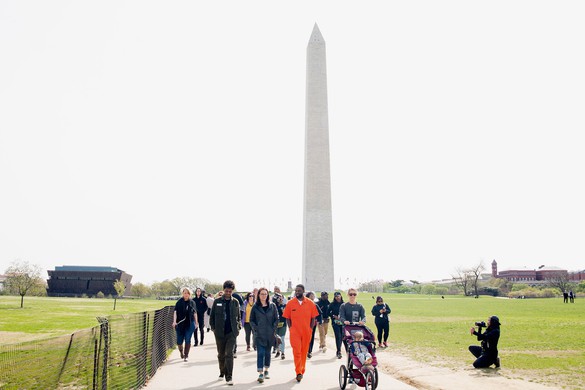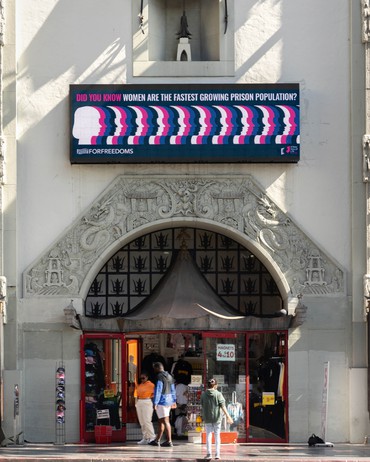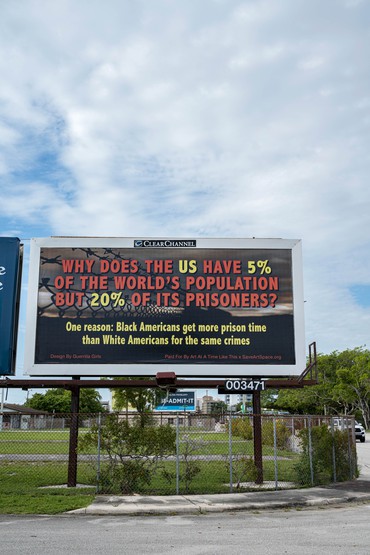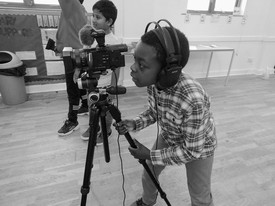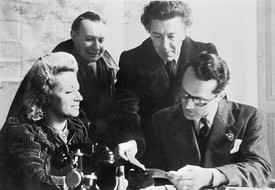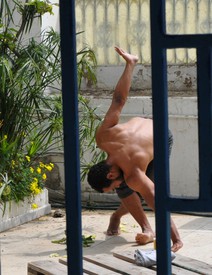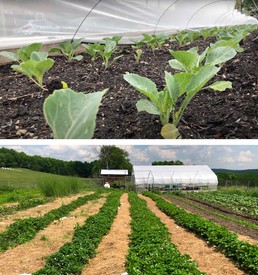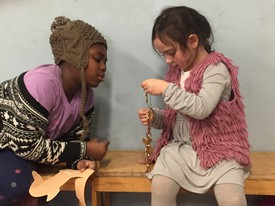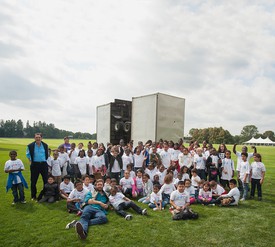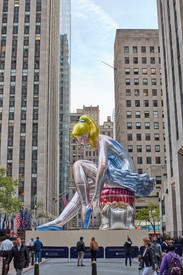
Salomé Gómez-Upegui is a Colombian-American writer and creative consultant based in Miami. She writes about art, gender, social justice, and climate change for a wide range of publications, and is the author of the book Feminista Por Accidente (2021).
Over the past forty years, the United States has seen a 500-percent increase in its prison population.1 Today, more than 2 million people are incarcerated here, meaning one out of five prisoners in the entire world is in the so-called land of the free.2 A closer look at these numbers reveals that Black people in the United States are imprisoned at almost six times the rate of white people.3 And while Black men make up around 6.5 percent of the US population, they make up close to 40 percent of the entire prison population.4 The issue of mass incarceration in the United States is a human-rights crisis that can no longer be ignored.
Activists in this country have tirelessly denounced mass incarceration. Poets such as Bryonn Bain and Reginald Dwayne Betts have called for justice and prison reform for decades. Collectives such as Critical Resistance have challenged America’s prison-industrial complex and pushed for abolition. And there is of course the work of scholars such as Michelle Alexander, whose seminal book The New Jim Crow (2010) emphasized the atrocious effects of mass incarceration on people and communities of color. “When the system of mass incarceration collapses (and if history is any guide, it will),” Alexander writes, “historians will undoubtedly look back and marvel that such an extraordinarily comprehensive system of racialized social control existed in the United States. How fascinating, they will likely say, that a drug war was waged almost exclusively against poor people of color . . . stigmatized for life, denied the right to vote, and ushered into a world of discrimination.”5
Recently, it has seemed as though the relentless efforts of these longtime advocates are finally garnering the attention they deserve. The call to end mass incarceration in the United States has become louder, notably within the art world. Art collectives are addressing the subject, major institutions are organizing topical exhibitions, and, most important, formerly and currently incarcerated artists are receiving long-overdue support.
In 2015, the renowned philanthropist Agnes Gund sold a Roy Lichtenstein painting from her personal collection for $165 million and designated $100 million of that to create the Art for Justice Fund, a decarceration fund with a mission of reducing the number of people in prisons and jails throughout the United States. The story goes that Gund decided to launch the project after seeing Ava DuVernay’s documentary 13th (2016), which unveils the gruesome reality of America’s broken carceral system. Since its official launch, in 2017, Art for Justice has galvanized the art world around the topic of mass incarceration, receiving donations from artists such as Nick Cave, Jeff Koons, and Julie Mehretu, and supporting hundreds of individuals and organizations. Due to its nature as a catalytic spending fund, the initiative will sunset in June 2023, but Helena Huang, project director of the fund, is confident that the increased attention being paid to mass incarceration in the American art world will continue well beyond its closure. “My belief is that others will come with new ideas, new resources, and ways of functioning. It’s like a garden that we’ve helped nurture and plant—some will continue with those seeds, and this community will continue to grow and have ripple effects,” she told me.6 Huang also believes that the burgeoning conversation about mass incarceration reflects the sheer number of lives touched by America’s relentless carceral system. “Thousands of people have come home from prisons and jails and have assumed their rightful position leading advocacy organizations and spearheading the fight to end mass incarceration,” she explains.7
Another powerful example of a thriving initiative stems from Nicole Fleetwood’s critically acclaimed book and exhibition Marking Time: Art in the Age of Mass Incarceration, which debuted at MoMA PS1, in Queens, New York, in 2020. Marking Time showcases the work of more than thirty artists, many of whom are or have been incarcerated; it is currently traveling around the country and is often accompanied by public-education and community-oriented programs. The project illustrates the importance of art as an essential medium to spotlight the brutal failures of America’s prison system.
Claudia Peña, executive director of For Freedoms, a coalition of academics, artists, and organizers, founded in 2016, that centers art and creativity to catalyze liberation, echoes this sentiment. “There are more formerly incarcerated and currently incarcerated artists now. And that’s changed the narrative because they have the ability to tell the story in a way that nobody else can. It’s so compelling and so powerful that people can’t help but pay attention,” Peña says.8 In the past, For Freedoms has championed diversity and social justice by revamping Norman Rockwell’s Four Freedoms paintings for Time magazine and launching national billboard campaigns tied to election cycles. Their most recent initiative, “Another Justice: By Any Medium Necessary,” calls for a rethinking of the possibilities of justice during a time of imbalance and includes a nationwide billboard campaign, launched in May of this year, exhibiting more than fifty artworks that reflect on the criminal justice system. One Los Angeles billboard was designed by Susan Burton, founder of A New Way of Life Reentry Project, a nonprofit organization that supports formerly incarcerated people in the process of rebuilding their lives; her billboard read, “Did you know women are the fastest growing prison population?” Another, in Atlanta, made by artist Jared Owens, stated “Build schools, not prisons.”
As an artist who was once incarcerated, Owens understands the ruthlessness of the prison complex firsthand and has dedicated a great deal of his work to underscoring the importance of the subject, often receiving meaningful support from art organizations along the way. He was a recipient of the Right of Return USA Fellowship, the first national fellowship supporting previously imprisoned artists, founded in 2017 by formerly incarcerated artists Jesse Krimes and Russell Craig in partnership with the Soze Agency. He is also a current fellow at Silver Art Projects, a New York–based nonprofit offering mentorship and free studio spaces to artists from underserved communities. Silver Art recently announced that it intends to assign a quarter of all future residency spots to formerly incarcerated artists.
Another organization using billboards to display artworks that bring attention to mass incarceration is Art at a Time Like This. Founded in 2020 by independent curators Barbara Pollack and Anne Verhallen, Art at a Time Like This is a nonprofit that explores the power of art and artists to make a difference in turbulent times. “We think mass incarceration is the biggest crisis the US is facing right now and we think art is at the essence of starting conversations about change,” says Verhallen.9 “The thing with mass incarceration is that it has touched everybody in this country. It has destroyed certain communities, and everyone knows somebody who has been harassed by the police, wrongfully charged, or unable to pay bail. We are finding that artists of all sorts of different backgrounds have been personally affected by this,” Pollack adds.10
Earlier this year, Art at a Time Like This debuted “8x5,” a billboard project, its title alluding to the average size of a prison cell. Showcasing commissioned works by artists such as Shepard Fairey, Guerrilla Girls, and Trenton Doyle Hancock on billboards across Miami, the project focuses on sharing information about mass incarceration in Florida. One particularly harrowing billboard, created by multidisciplinary artist Sherrill Roland, states that roughly 17,000 wrongfully incarcerated people currently sit in Florida prisons.
As a graduate student, Roland was wrongfully incarcerated and spent ten months in prison before being fully exonerated. Upon regaining his freedom, he returned to graduate school and began The Jumpsuit Project, a performance in which he wore an orange prison jumpsuit on campus for a year, including during his graduation ceremony, to share his story and interrogate the trauma of incarceration. Mostly, Roland says, The Jumpsuit Project was intended to engage communities outside of traditional art institutions on the issue of mass incarceration. “There are a lot of invitations extended to incarcerated and formerly incarcerated artists to participate in these institutional spaces,” he says, “but there should be some outward efforts to engage communities too. These conversations don’t always have to happen in a four-white-wall space.”11
Empowerment Avenue is an organization that is adamant about community-building and engagement with incarcerated artists and writers. Cofounded in 2020 by journalist Emily Nonko and incarcerated journalist Rahsaan “New York” Thomas (who is also a cohost of the Pulitzer Prize–nominated podcast Ear Hustle, to which he contributes from San Quentin State Prison in California), it is devoted to building networks that help incarcerated creatives to access mainstream venues and get paid for their talents. And although Nonko and Thomas have previously worked mostly with writers, they have recently begun to expand their outreach to artists. “We’ve started seeding what an artists cohort can look like in San Quentin, and we’re also seeding an artists cohort at the women’s central facility in Chowchilla, California—that’s going to be in 2023,” Nonko says. “Rahsaan has curated the art that’s come out of San Quentin for a few shows. And so we’re also thinking about what it means to have curators in prison so that shows can be envisioned from inside. And then we can take that model and push outside institutions to make space for it.”12
Given the long US tradition of marginalizing and overlooking people in prisons, to center the voices of currently and formerly incarcerated artists is fundamental in efforts to confront and end mass incarceration. “I think for so long we’ve held this narrative that people in prisons have nothing to contribute to society,” Nonko explains, “but that myth can be dismantled in five minutes. It falls apart as soon as you start talking with someone who is or has been incarcerated, when you hear their perspectives, see their artwork, and hear about their life story.”13
Nonetheless, an unintended consequence of turning to directly affected individuals to discuss and solve this problem is the risk of permanently labeling them as incarcerated, even after they’ve left that part of their story in the past. Owens is particularly vocal about this concern. Regardless of the awareness he wants to bring to the American criminal-justice crisis, he also knows that his experience in prison doesn’t tell his entire story. “I’m an artist first; it just so happens to be that I was incarcerated,” he says. “So that’s a challenge for me, to get past all that, because human beings like to pigeonhole and categorize everything so they can deal with it. And I like to think I don’t fit in any conventional boxes.”14 In a similar vein, Roland speaks of the importance of giving formerly and currently incarcerated artists the credit that is otherwise given to all others. “I would love for honor and respect to still be afforded to the work, even though it’s coming from these atypical spaces,” he says. “Don’t diminish or take anything away from it because of its origin story.”15
Still, the indisputable truth is that artists who have experienced the brutality of the prison system are uniquely poised to raise awareness on the matter. “We need to create a durable narrative change about the carceral system in this country,” says Huang. “We need the stories of Jared Owens and Jesse Krimes and so many other artists who have come home from prison, understand the complexities, and can explain that we’ve created an $80 billion carceral system that is doing more harm than good. These narratives help us understand how destructive this system is on every level.”16
Moreover, Peña believes that using art to tell these stories is especially urgent, since art has the unique power to change hearts and minds, helping us to interrogate our personal ideas around justice—“and not just around the big criminal legal system and prisons,” she says, “but also around how we think about harm and punishment in our own interpersonal relationships. What do you do when someone has harmed you? What do you do when you harm somebody? Are you good at apologizing? All of the ways in which we think about these things at the individual and interpersonal level add up and inform the larger systems that exist.”17
For all of the gut-wrenching statistics and difficult realities revealed when discussing mass incarceration in the United States, there is space for hope. The increased attention being paid to artists, activists, and organizations fighting to imagine a different, more just future in which “mass incarceration collapses”—to use the prophetic language of Michelle Alexander—is a testament to that. Change can and does happen, but as Nonko says, “it just doesn’t happen without art.”18
1See the Sentencing Project, “Criminal Justice Facts,” 2022. Available online at www.sentencingproject.org/criminal-justice-facts (accessed August 24, 2022).
2ACLU, “Smart Justice,” 2022. Available online at www.aclu.org/issues/smart-justice/mass-incarceration (accessed August 24, 2022).
3See the Sentencing Project, “Criminal Justice Facts.”
4See Ava DuVernay, 13th (Sherman Oaks: Kandoo, 2016). As of this writing the film is available on Netflix.
5Michelle Alexander, The New Jim Crow: Mass Incarceration in the Age of Colorblindness (New York: New Press, 2010), p. 170.
6Helena Huang, in an interview with the author, July 28, 2022.
7Ibid.
8Claudia Peña, in an interview with the author, July 21, 2022.
9Anne Verhallen, in an interview with the author, July 18, 2022.
10Barbara Pollack, in an interview with the author, July 18, 2022.
11Sherrill Roland, in an interview with the author, July 21, 2022.
12Emily Nonko, in an interview with the author, July 21, 2022.
13Ibid.
14Jared Owens, in an interview with the author, July 7, 2022.
15Roland, interview with the author.
16Huang, interview with the author.
17Peña, interview with the author.
18Nonko, interview with the author.
